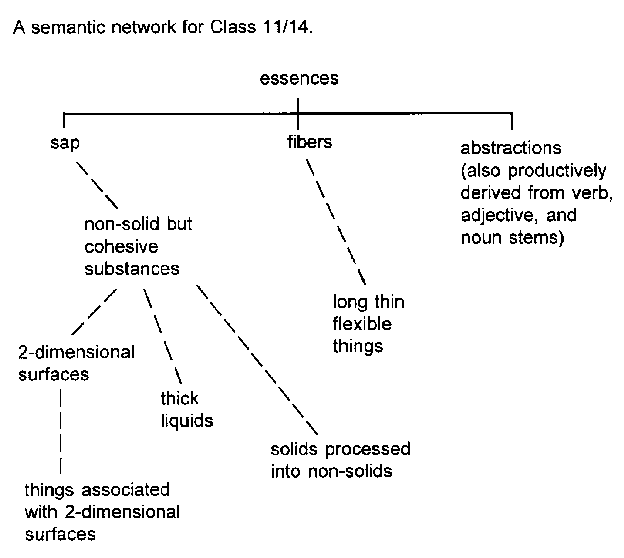
Next, Class 11/14. To view a representative list of nouns in each semantic category, click on that portion of the chart.
In Swahili this class is historically derived from a merger of Bantu Class 14 (*bu-) with Class 11 (*lu-). This is a fairly recent development (Nurse and Hinnebusch reconstruct 11 and 14 as distinct classes in Proto-Sabaki). This merger is usually attributed solely to phonological factors (the loss of *l and *b- before -u), and most Swahili scholars describe the resulting class as `semantically confused'. In the words of Nurse and Hinnebusch, `long thin objects (Class 11) and abstracts (Class 14) are hard to reconcile' (N&H 350). However it must be pointed out that even before the time of Proto-Sabaki there was some semantic overlap between Classes 11 and 14 that is not usually recognized. First of all, both classes contained some nouns referring to two-dimensional surfaces or things metonymically related to them, as may be seen from the lists of examples associated with the chart. Thus the word ulili meaning `platform' or `bedstead' is reconstructed for both classes 11 and 14 by Nurse and Hinnebusch; the rest of the reconstructed words in these two categories are evenly divided between Classes 11 and 14.
Another area of semantic overlap between the two original classes is that of cohesive substances, which fall somewhere between solid and liquid. If spatial delineation in one or two dimensions was a major characteristic of pre-Sabaki Class 11, and if individuation without countability was a characteristic of Class 14, then the cohesive substances may be thought of as a semantic bridge between the two: they preserve their shape, and have an intimate relationship to surfaces, but are not discrete enough to be countable.
It seems likely that the semantic structure of this class has been reorganized to accomodate the merger between the former 11 and 14. In the diagram I suggest the term "essences" to indicate a relationship between the more concrete vegetative substances-- sap and fiber-- and the productive use of Class 11 to derive abstractions (for example, mtoto (1) 'child'/utoto (11) 'childhood'; jamaa (9) 'family, society'/ujamaa (11) 'socialism'). A parallel relationship, though not as productive, exists between names of plants (in Class 3) and their usable sap or fiber (the same stem in Class 11), for example, mgomba (3) 'banana plant'/ugomba 'banana plant fiber'; mlimbolimbo (3) 'thorny hedge plant'/ulimbolimbo (11) 'sap of mlimbolimbo, used for fish poison'; msufi (3) 'kapok plant'/usufi (11) 'kapok fiber'. Other word pairs show analogous relationships: the Class 11 prefix indicates inner substance or constitutive part. For example, mfupa (3) 'bone'/ufupa 'bony substance, cartilage'; ndevu (9) 'beard'/udevu 'single facial hair'; taya (5) 'jaw'/utaya (11) 'jawbone'; mti (3) 'tree'/uti (11) 'stem, trunk of tree; backbone'.
The fact that inner substances can sometimes be sticky liquids and sometimes fibers can explain the association of Class 11 with extendedness in two dimensions vs. one. As suggested above, the cohesive qualities of sap may motivate the extension to other cohesive substances as well as to 2-dimensional surfaces, with which cohesive substances have an intimate relationship. Fibers on the other hand are long and thin, which explains the connection to long thin things in general[20].
The categories `things ground up into particles' and plants processed into non-solid substances' are connected to spatially delineated but non-countable substances in that they start out as delineated solids but become non-solid, hence non-countable.